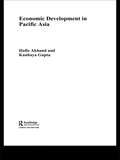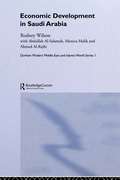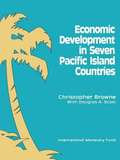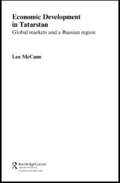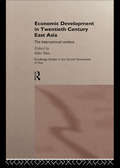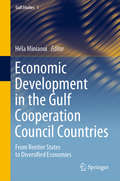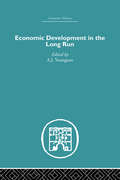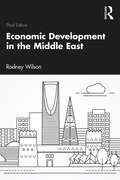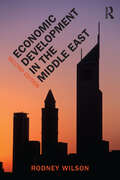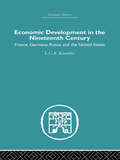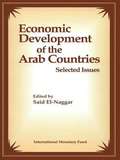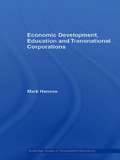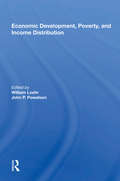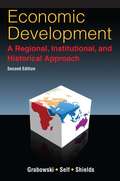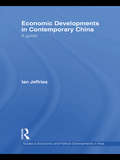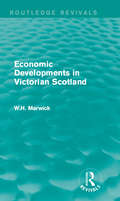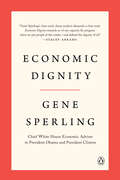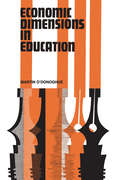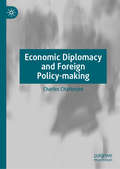- Table View
- List View
Economic Development in Pacific Asia
by Hafiz Akhand Kanhaya GuptaDuring the period 1965 to 1990 East Asia was the world’s fastest growing region. Economic Development in Pacific Asia provides illuminating, non-technical perspectives on key facets of the region’s economies. The text focuses on the eight countries which accounted for the majority of the economic growth: Japan, Hong Kong, Taiwan, Republic of Korea, Indonesia, Malaysia, Singapore and Thailand. Empirical evidence is used to provide a revealing, multi-dimensional statistical profile of the countries as well as the region as a whole. Rather than present a statistical history of each country, the text highlights the relative performance in terms of the variables which are studied within each chapter. Akhand and Gupta examine a range of popular topics including: the relative role of factors accumulation versus technology change factor price distribution and employment growth, poverty and income distribution the Asian Crisis and corruption. In addition, the book examines topics rarely covered in the current economics literature such as urbanization, the gender gap and the digital divide. It provides an accessible and wide ranging assessment of the existing evidence and current arguments on East Asian economic development, and is a valuable addition to economists, policy makers and those interested in Asian economic affairs.
Economic Development in Saudi Arabia (Durham Modern Middle East and Islamic World Series)
by Rodney Wilson Monica Malik Ahmed Al Rajhi Abdullah Al SalamahThe changing political situation in the Middle East poses challenges for the economies of the region, and some see none more vulnerable to collapse than Saudi Arabia's. Yet as this study demonstrates, the fundamentals of the Kingdom's economy are relatively robust, as over three quarters of GDP is accounted for by the non-oil sector, and impressive modern industries have been established, notably in petrochemicals. The financial system functions well, and despite substantial government debts, there is low inflation and currency stability. The private sector increasingly drives the economy, although job creation has been insufficient to prevent rising youth unemployment. The development challenges Saudi Arabia faces are similar to those of other middle-income countries, and three decades of diversification have made the economy less unique than it was in the oil boom years of the 1970s.
Economic Development in Seven Pacific Island Countries
by Douglas A. ScottA report from the International Monetary Fund.
Economic Development in Tatarstan: Global Markets and a Russian Region (Routledge Contemporary Russia and Eastern Europe Series #Vol. 4)
by Leo McCannBased on extensive original research in the Republic of Tatarstan, in the Central Volga region of Russia, this book examines the economic development path followed by Tatarstan since the collapse of the Soviet Union and the Russian financial crash of 1998. It argues that the roles of global capitalism and globalisation are somewhat exaggerated in much contemporary academic literature. In the case of Tatarstan, a strong state role, tightly-knit local elite networks, and the inheritance of the Soviet politic and industrial systems are the most important socio-economic formations in explaining the region's development.
Economic Development in Twentieth-Century East Asia: The International Context (Routledge Studies in the Growth Economies of Asia)
by Aiko IkeoThis collection supplies fascinating insights into aspects of East Asian economic development. It will interest scholars in a variety of related fields and provoke further research and debate.
Economic Development in the Digital Age
by Nagy K. HannaIn this book, Nagy K. Hanna offers a holistic framework that economists and policymakers can use to examine and drive digital transformation. The book offers detailed analyses into development policies, and organizational processes governing digital transformation learning and practice and highlights the reforms needed in countries and aid agencies to meet the challenges of the 21st century. The author offers insight to help reform major aid agencies within the economic development space. The resulting text reimagines the future of development economics.
Economic Development in the Gulf Cooperation Council Countries: From Rentier States to Diversified Economies (Gulf Studies #1)
by Héla MiniaouiThis book delves into the economic development of the six Gulf Cooperation Council (GCC) countries. Since the 1960s, the GCC states have harnessed their potential to exploit the wealth accrued from the oil boom to build their infrastructure and grow their economies. However, the high level of dependency on oil as the primary source feeding their output made their economies volatile and vulnerable to fluctuations in the global oil prices. Moreover, the plunge in oil prices and the threat of depletion of this natural resource pose serious challenges to the GCC countries. Consequently, the GCC governments have realized the importance of diversifying their economies following the need to move away from reliance on hydrocarbon.This book contributes to the theoretical literature by enriching the debate on the transition of the GCC countries from rentier states to diversified economies. It helps students and scholars understand this transformation with an expansive comprehension of the contemporary challenges facing the region, as well as outlining prospects for the future.
Economic Development in the Long Run (Economic History Ser.)
by A. J. YoungsonThis book enlarges our understanding of economic development by bringing together items or aspects of historical experience relevant to the present-day problems of developing countries; by looking at the problems over a longer period than is usual in development economics, so that the influence of underlying forces may be made evident; and by comparing the experiences of different countries in similar situations. A variety of countries are dealt with and most of the significant problems in development economics are covered in one context or another. The authors of this symposium, each an internationally acknowledged authority, offer expert assessments of development as it has actually taken place. The chapter by Professor Rosovsky shows what is significant, what is peculiar and what could be imitated in Japan; Professor Black takes the little-studied case of Ireland, and Dr Macpherson gives an informed and balanced account of Indian development. This unique book was first published in 1972.
Economic Development in the MENA Region: New Perspectives (Perspectives on Development in the Middle East and North Africa (MENA) Region)
by Mohamed Sami Ben AliThis book offers new perspectives on the economic development of the Middle East and North Africa region. Offering both theoretical studies and empirical country studies, it examines micro- and macroeconomic issues and provides deep insights into the development challenges and prospects of various countries in the region. The articles examine a wide range of development issues, including economic growth, natural resource use, food security, poverty and inequality, corruption and transparency, military spending, water and resource scarcity, agriculture and aid effectiveness, and other relevant issues. The volume is aimed at scholars in economic and development studies as well as policy-makers and investors interested in the economic development of the MENA region.
Economic Development in the Middle East
by Rodney WilsonThis new edition examines how development in the Middle East is being influenced by global economic change. This comparative textbook focuses on the region’s strengths, and highlights development success, especially in the Gulf, Turkey and Israel. The major structural changes in the economies of the Middle East are analysed and current employment challenges are discussed. The impact of demographic changes is considered, notably the dramatic decline in birth rates which will have implications for future employment. The contribution of banks and capital markets to the region’s development is appraised, including that of Islamic financial institutions which play a prominent role in the Gulf Cooperation Council (GCC) countries but are on the margins of the financial systems elsewhere. Historically, development in the GCC was linked to oil and gas production and prices, a key issue being whether these are being decoupled as economies diversify and become more self-sustaining. The evidence on this from the GCC is encouraging, with transparent and accountable financial management and major improvements in economic governance despite the lack of democracy. Examining the drivers of economic development in the Middle East in a regional and global context, this fully updated textbook is a key resource for students and academics interested in economic development and the political economy of the Middle East.
Economic Development in the Middle East, 2nd edition (Routledge Studies In Development Economics Ser.)
by Rodney WilsonBy examining economic development in the Middle East in the aftermath of the Arab Spring, this textbook introduces undergraduate and postgraduate students to the most pressing and topical economic issues in the contemporary Middle East. With comprehensive coverage of the entire region, the author examines the economic prospects for the Gulf and charts the growth of economic power in the region. Organised thematically, a full range of topics are discussed, including: the role of banks and capital markets in the region’s development the impact of demographic changes, such as the dramatic decline in birth rates and the implications for future employment the development of economic advances in oil and gas production the effects of the region’s economic development on international and inter-regional trade. Through discussing the region’s problems of the past as well as the present and future challenges, this book provides students with a compact and manageable review of the state of economic development in the Middle East.
Economic Development in the Nineteenth Century: France, Germany, Russia and the United States
by L.C.A. KnowlesTaken in conjunction the author’s earlier Industrial and Commercial Revolutions in Great Britain during the Nineteenth Century, this classic volume provides a thoroughly workmanlike study of the rise and progress of industrialism. Here she surveys the main developments in the agricultural, industrial, mechanical transport and commercial policy of France. Germany, Russia and the United States. It provides the handiest manual available of the comparative history of industrialism. It is an absolute godsend to students. This book was first published in 1932.
Economic Development in the World's Smallest Economies: How Geography, Demographics, and Culture Define Economic Activity
by Aneta A. TeperekThis book examines three fundamental factors that influence the economic growth and development of the world's 93 smallest economies, which together produced 1% of global GDP. The objective of the study is to ascertain whether the countries analysed possess the requisite environmental resources, human capital, and cultural conducive to economic development, and whether they effectively utilize their resources. Consequently, the location and elements of physical geography are analyzed, including climate, soils, landforms and geological structure from the perspective of mineral resources abundance as well as marine and inland water from the perspective of water resource abundance. The changes in population from 1970 to 2019 are studied and the factors determining them, which are natural increase and migration. Finally, the demographic structure are examined. The analysis of cultures, including religions and languages, is undertaken to identify cultural factors that either support or hinder economic growth and development. This book is designed for students and researchers engaged in the study of economic geography, geography, demography, and macroeconomics. It serves as a valuable resource for international organizations engaged in the analysis of countries across the globe.
Economic Development of China and Japan
by C. D. CowanFirst published in 2005. Routledge is an imprint of Taylor & Francis, an informa company.
Economic Development of the Arab Countries
by Said El-NaggarA report from the International Monetary Fund.
Economic Development, Education and Transnational Corporations (Routledge Studies In Development Economics Ser.)
by Mark HansonThis book focuses on the questions of: why do some economically disadvantaged nations develop significantly faster than others, and what roles do their educational systems play? In the early 1960s Mexico and South Korea were both equally underdeveloped agrarian societies. Since that time, the development strategies pursued by each country resulted
Economic Development, Poverty, And Income Distribution
by John P. Powelson William LoehrThe increasing inequality and poverty that seem inevitably to accompany economic growth in developing countries have become more and more evident in recent years. The search for development paths that lead to growth with equality—all too difficult to find—is now an area of central concern for development economists. One result of their concern is this volume, in which internationally known representatives of a range of disciplines address themselves to ways in which growth with equity might be successfully achieved. The book begins with both empirical and theoretical background to the development issues involved, and with an overview of the experience of the international development assistance community. focuses on operational definitions of the poor that will permit analytical, policy-oriented research to lead to useful conclusions. Specific concern is expressed for small-business owners, women, peasants, and recent migrants from rural to urban areas. The basic question, of course, is what can be done about poverty and inequality. includes suggestions for specific measures and provides a comprehensive comparison across a wide range of policy options. The book does not solve the problem, but it does point to directions that promise a reasonably high probability of success. And throughout, suggestions are made for the kind of interdisciplinary research required to raise that probability even further.
Economic Development: A Regional, Institutional and Historical Approach
by Richard Grabowski Sharmistha Self William ShieldsThe second edition of this innovative and affordable book integrates environmental and financial sustainability into its distinctive regional approach. By focusing on political economy in its cultural, religious and historical roots, as well as leadership decisions, it spurs critical thinking. Working through the unique development paths of individual countries, the authors foster integrative thinking and a strong sense of realism about both the prospects and challenges of economic development in the rapidly evolving global economy. The book is exceptional in both its theoretical nuance and accessible writing. An Instructors Manual with discussion questions, a test bank, and PowerPoint slides is available online to professors who adopt the text.
Economic Development: The History of an Idea
by H.W. Arndt"Economic Development makes an important contribution of the literature on economic development, especially as it incorporates ideas on a theme that informs our concern for social justice, individual and social freedom, identify, and community."—Winston E. Langley, Annals of the American Academy of Political and Social Science
Economic Developments in Contemporary China: A Guide (Guides to Economic and Political Developments in Asia)
by Ian JeffriesChina’s role in global affairs today continues to rise. This book provides an authoritative, comprehensive and detailed overview of contemporary economic developments in China. Key topics include agriculture; the market gradually replacing central planning; the global financial crisis; the reform of state-owned industrial enterprises; the non-state sectors; the ‘open-door’ policy (including the WTO, exchange rate policy, and inward and outward direct foreign investment); and China’s economic performance in general. The book continues - and adds to – the overview of developments up to May 2006 which were covered in the author’s China: A Guide to Economic and Political Developments (2006), and is the companion volume to Political Developments in Contemporary China: A Guide (2010) - both published by Routledge.
Economic Developments in Victorian Scotland (Routledge Revivals)
by W.H. MarwickMarwick argues that economic development in Scotland was severely delayed until the 18th Century unlike neighbouring countries. Originally published in 1936, this study aims to explore key features of economic development in Victorian Scotland to promote more understanding of this issue. Issues discussed include ownership of land and capital, administration and finances of industry, organisation of trade and marketing, labour and recruitment, trade unions, housing and other aspects which impact on the standard of life. This title will be of interest to students of Economics and Industrial History.
Economic Dignity
by Gene SperlingFrom one of our wisest and most influential economic thinkers, the only person to serve as Director of the National Economic Council under two Presidents, a profound big-picture vision of why the promotion of dignity should be the singular end goal by which we chart America's economic futureWhen Gene Sperling was in charge of coordinating the shaping and execution of the US government's economic policy in the Obama White House, he found himself surprised and dismayed when serious people in Washington worried out loud to him that the Obama focus on health care was a distraction because it was "not focused on the economy." How, he asked, was millions of Americans' fear that they were a single pink slip or a loved one's serious illness away from financial ruin somehow not considered an economic issue? To him, it was just one more example of a more profound truth he witnessed in his many years in our national economic debate: that when it comes to America's economic policy, there is too little focus on what the end goal should be.Too often, he found that our economic debate confused ends and means; that we measured economic success by metrics like GDP instead of whether the economy was succeeding in lifting up the sense of meaning, purpose, fulfillment, and security of people. Too often, he found debates framed by old divisions or pro-market ideology that increasingly failed to capture whether economic policy was fostering exploitation, economic insecurity, and disillusionment that were too often invisible within our current framework. Now more than ever, at a moment when the very capacity of modern capitalism to avoid accelerating inequality, a hollowed-out middle class, and structural poverty is being questioned, we need to step back and reflect on our ultimate goals.Economic Dignity is Sperling's effort to do just that - to frame our thinking about the way forward in a time of wrenching economic change. His argument combines moral and intellectual seriousness with actual high-level policy experience. Economic dignity, Sperling maintains, can be seen as resting on three pillars. The first: the capacity to care for family without economic deprivation denying people the capacity to experience its greatest joys - the birth of one's children, the companionship of a loving partner, the love of family and friends, the fulfillment that comes from providing. The second: the right to the pursuit of potential and purpose, including the right to first and second chances - the right to a life of active striving. The third: economic participation with respect and without domination and humiliation. All three pillars are rooted in the highest and most noble values of the American project. But getting there is the rub, and in Economic Dignity, Sperling offers paths that policymakers and citizens can follow for years to come. As he puts it, if you live in times when major steps forward are needed, it is important to be clear on your destination - or at least to know the North Star that is guiding you. His answer, in two words, is economic dignity.
Economic Dimensions in Education
by Martin O'DonoghueThis book examines the economic issues of education from an unusually systematic and broad perspective. Although the book is soundly based in economic theory, it is not heavily mathematical.Economic Dimensions in Education is designed to provide an introductory analysis of economic issues in education both in academic life and in the general community. Some of the issues discussed include the nature and reasons for public sector activity in education, the role education plays in providing skilled human resources for an economy, and the economic consequences of migration between countries of educated peoples. The book also deals with various aspects of demand: patterns of educational demand, individual demand for education as a form of social investment for the community, and supply aspects of education as related to types and sizes of educational establishments and problems of ensuring the efficient provision of education.There has been a growing interest in the economic aspects of education. The considerable growth in the volume of educational activity is now at the point where today education is one of the largest industries in most countries and also one of the chief employers of highly skilled personnel. The recognition that education may have a significant influence on the employment and income opportunities and hence affect the distribution of income and wealth in society is also a factor. A final reason stems from the post-war emphasis on economic growth and development, with education playing an important role as a provider of skilled personnel for an economy.This classic volume is comprehensive, clearly written, and will appeal to undergraduates and first-year graduate students. The treatment is firmly embedded in economic theory and is must reading for those professional economists concerned with education.
Economic Dimensions of Personalized and Precision Medicine (National Bureau of Economic Research Conference Report)
by John Rowe Ernst R. Berndt Dana P. GoldmanPersonalized and precision medicine (PPM)—the targeting of therapies according to an individual’s genetic, environmental, or lifestyle characteristics—is becoming an increasingly important approach in health care treatment and prevention. The advancement of PPM is a challenge in traditional clinical, reimbursement, and regulatory landscapes because it is costly to develop and introduces a wide range of scientific, clinical, ethical, and socioeconomic issues. PPM raises a multitude of economic issues, including how information on accurate diagnosis and treatment success will be disseminated and who will bear the cost; changes to physician training to incorporate genetics, probability and statistics, and economic considerations; questions about whether the benefits of PPM will be confined to developed countries or will diffuse to emerging economies with less developed health care systems; the effects of patient heterogeneity on cost-effectiveness analysis; and opportunities for PPM’s growth beyond treatment of acute illness, such as prevention and reversal of chronic conditions. This volume explores the intersection of the scientific, clinical, and economic factors affecting the development of PPM, including its effects on the drug pipeline, on reimbursement of PPM diagnostics and treatments, and on funding of the requisite underlying research; and it examines recent empirical applications of PPM.
Economic Diplomacy and Foreign Policy-making
by Charles ChatterjeeThis book aims to identify what components are needed for economic diplomacy in today’s rapidly changing world, looking at the nature, focus and tenets of economic diplomacy, and the differences between economic diplomacy and commercial diplomacy. Further, it considers the new kind of diplomacy that will be required for emerging markets, in contrast to maintaining the traditional techniques used for economic diplomacy between states. The author emphasises the negotiating techniques necessary for successfully engaging in economic diplomacy in the current diplomatic atmosphere. Importantly, it also discusses how to pursue economic diplomacy at international fora and with regard to private foreign investments. Lastly, it addresses the role of non-governmental organisations in economic diplomacy. Given its scope, the book will benefit not only practicing diplomats, but also graduate students.
